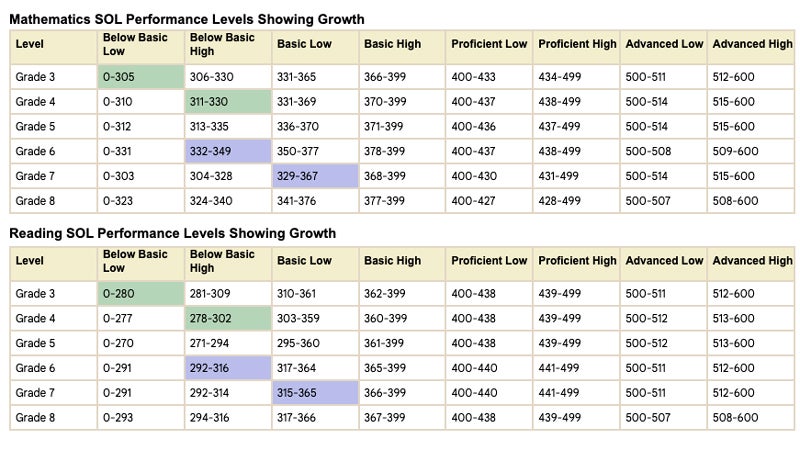State accreditation standards ‘unreliable?’
Published 3:36 pm Tuesday, October 11, 2022

- Under the 2018 accreditation formula factoring in "growth," a third-grader who scores between zero and 280 on the reading SOL would be classified as “below basic low," but could move to "below basic high" by scoring between 278 and 302 in fourth grade. He or she would then be recorded for accreditation purposes as having passed due to showing sufficient growth – even in the event his or her actual score dropped from 280 to 278. (Charts courtesy of Virginia Department of Education)
Isle of Wight, Surry still show pandemic learning loss, but some schools buck trend
State Superintendent of Public Instruction Jillian Balow contends Virginia’s accreditation standards are “unreliable” given the number of schools reaccredited despite having yet to return to their pre-pandemic pass rates on the state Standards of Learning tests.
According to Virginia Department of Education data, 1,628 public schools statewide – including all nine in Isle of Wight County and all three in Surry County – were reaccredited for the 2022-23 school year. The total represents a decline of only 3.2% from the 1,682 schools accredited in September 2019.
“These ratings call into question the effectiveness of our accreditation standards in identifying schools where students are struggling to achieve grade-level proficiency,” Balow said in a Sept. 22 press release. “The number and percentage of schools earning accreditation is almost as high as three years ago, despite significant declines in achievement on Standards of Learning tests in reading, math and science — especially among minority and economically disadvantaged students. Accreditation is one of the primary drivers of state interventions and local efforts to improve outcomes for students, and frankly, the school ratings we are releasing today fail to capture the extent of the crisis facing our schools and students.”
According to VDOE data, 79% of Carrollton Elementary students passed the reading SOL in 2019, while only 73% passed in 2022. The number of white Carrollton students passing the reading SOL fell by only two percentage points from 2019 to 2022, compared to a 10-point drop among Black students.
The performance of Smithfield High School students on the 2022 math SOL, however, bucks Balow’s claim. According to VDOE data, the number of students passing the math SOL increased from 79% in 2019 to 85% this year, with the performance gap between white and Black students closing from 18 percentage points in 2019 to just seven points.
In Surry County, 66% of Surry Elementary students passed the 2022 reading SOL, reflecting no change from the 66% who’d passed the test in 2019. The pass rate among Surry Elementary’s Black students rose from 53% in 2019 to 56% in 2022 while the pass rate among white students fell from 79% in 2019 to 76% in 2022.
Isle of Wight’s divisionwide average scores exceeded the statewide pass rates on all tests. Surry’s divisionwide scores also exceeded the state pass rate on all tests except math and history. The gap between Surry’s pass rate and the state’s was only one percentage point for math, and eight percentage points for history.
According to grade-level data Isle of Wight Deputy Superintendent Susan Goetz shared at the county School Board’s Sept. 8 meeting, elementary school math scores exceeded the statewide pass rate by at least four percentage points. Middle school scores also exceeded the state pass rates in all subjects except science and writing.
Sixty percent of Georgie D. Tyler Middle School students scored a passing grade on the 2022 writing SOL compared to the statewide 65% pass rate, though the pass rate for Smithfield Middle School students was 67%.
On the science test, 64% of GTMS and 59% of SMS students passed compared to the 65% statewide pass rate.
“We’re not shocked that this happened, but it does tell us that we need to do more with helping the students, in eighth grade for example, with new content in sixth and seventh grade,” Goetz said, noting the eighth grade science test is cumulative for content taught in grades six through eight.
The grade-level scores, she noted, were true pass rates rather than those inflated by the “growth” indicator the VDOE uses when determining a school’s accreditation.
In 2018, the VDOE began measuring growth by classifying students who test below the passing score of 400 on an SOL into one of four performance levels: below basic low, below basic high, basic low and basic high. Under the 2018 growth charts, a third-grader who scores between zero and 280 on the reading SOL would be classified as “below basic low.” If that same student scored between 278 and 302 in fourth grade, he or she would be reclassified as “below basic high,” and be recorded for accreditation purposes as having passed due to showing sufficient growth – even in the event his or her actual score dropped from 280 to 278. A similar situation would occur if a fourth-grader were to score a “below basic low” score of 277, then in fifth grade score a “below basic high” score of 271, and be counted among those who passed.
According to the data Goetz shared, all Isle of Wight elementary and middle schools performed at least five percentage points higher than the statewide 75% benchmark in English and at least 10 points higher than the state’s 70% math benchmark with factoring in growth. Growth is not a factor at the high school level, she noted.
Since 2018, Virginia has designated its public schools as either “accredited” or “accredited with conditions” based on the combined SOL pass rate and growth, progress made in closing racial and economic achievement gaps, and chronic absenteeism. High schools have three additional indicators: drop-out rate, graduation rate and college, career and civic readiness. According to VDOE data, only 132 of Virginia’s total 1,825 public schools were designated “accredited with conditions” this year and only five were subject to an “alternative accreditation plan.” Another six were new schools.
According to an earlier memorandum from Balow, chronic absenteeism wasn’t calculated in this year’s accreditation ratings due to “student absences during the 2021-2022 school year that resulted from the extraordinary circumstances created by COVID-19,” which “may not necessarily be correlated to the school-level policies and procedures put into place.”
The VDOE did, however, still report chronic absenteeism figures for each school. The state benchmark, Goetz noted, is 15% or fewer students chronically absent – the term defined as missing more than 10% of school days. All schools except Carrsville Elementary exceeded this benchmark by at least six percentage points, with GTMS having the highest absenteeism rate at 45%, followed by Windsor High School at 41%.





